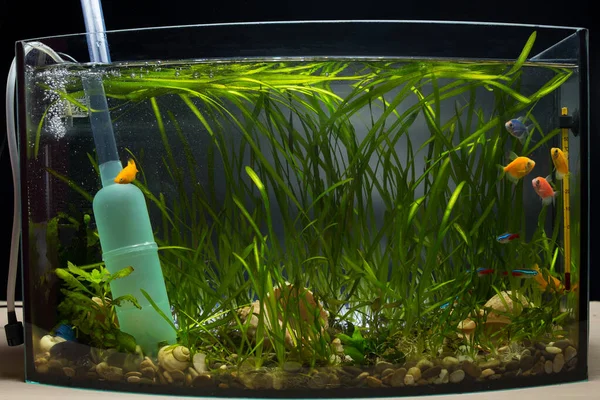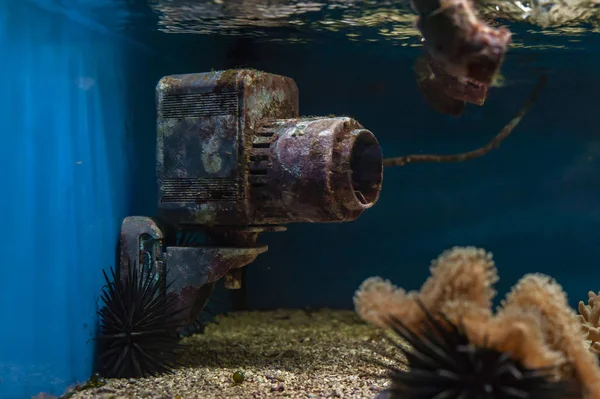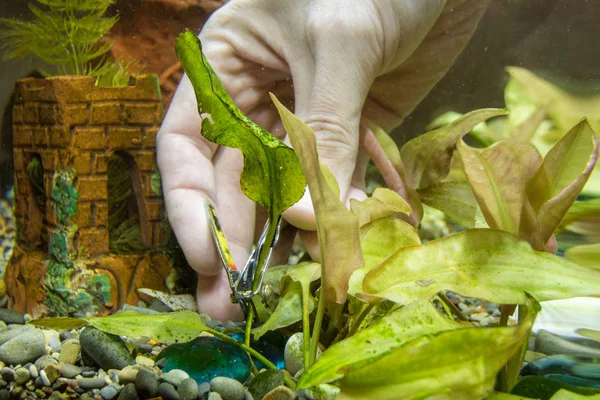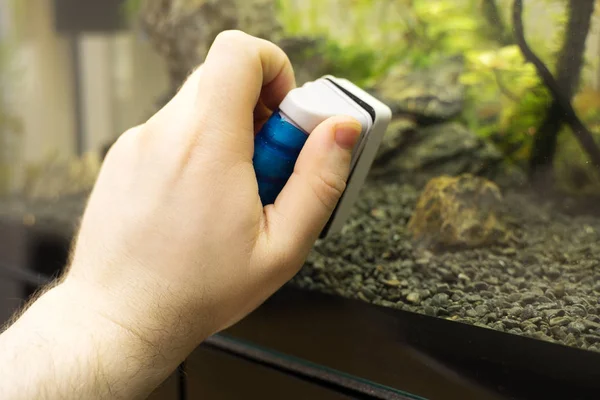Like any other home for one’s pets, fish tanks require maintenance over time. Fish breathe, eat, poop, and sleep all in the same place. And since they live in the water, all of this mess tends to float around, making keeping the system clean a little more complicated.
A well-stocked and managed aquarium should not take up too much of your time. And it should not get dirty very quickly. If your fish tanks are getting dirty fast, then there may be some underlying issue to think about.
Fortunately, in this comprehensive guide, I’ll break down the different issues on one of the most common questions “Why does my fish tank get dirty so fast?”
This way, you will be spending less time doing maintenance and more time enjoying your beautiful wet pets!
Types of Fish Tank Dirt

Why does your fish tank get dirty so fast? Dirty water is usually caused by any of the following issues in an aquarium.
Fish Waste
Fish waste is mostly fish poop and contributes to the bioload of your tank. Since it gets dropped into the water, it periodically needs to be removed through water changes. And in the meantime, your filtration system ensures that fish waste (and leftover foo) don’t become a huge problem.
Whether you have a powerful canister filter or a basic sponge filter, having some sort of filtration that is working properly is essential to fish health.
But if you are lax on performing filter maintenance, then problems with dirty water and other debris can quickly arise, no matter what size tank you have.
Leftover Food
Leftover food is another important reason why a tank can get dirty so fast. Unlike fish waste, leftover food is packed with nutrients that fuel algae and bacterial growth. Fish food can cause ammonia levels to quickly rise.
A healthy nitrogen cycle helps mitigate this, but you still don’t want too much uneaten food accumulating. Your helpful bacteria can only do so much.
Excessive Algae Growth
Algae is a fact of life for any fish tank you set up. Nutrients, water, and light mean that you will eventually have to clean up algae. A tank with a heavy bioload will always see more algae than one with a lighter bioload.
Algae come in many forms, with green algae being by far the most common. Aquarists also have to deal with brown (diatomaceous) algae, staghorn algae, black beard algae, and green water algae.

Algae is not always a sign that something is wrong. They are simply organisms taking advantage of light and nutrients that plants aren’t using. In fact, a continually algae-free tank can be a sign that there is something very wrong with your system.
How Much Light Does Your Tank Get?
Too much light is one of the main factors in helping algae take over in fish tanks. Are you running the aquarium lights for a long time? Anything more than 8 hours of full-power run-time will cause excessive algae growth.
Even if your lights are carefully controlled to not be on all of the time, sunlight from nearby windows is also a contributing factor. Sunlight is full-spectrum and ideal for plant growth. And it does not take much to help algae take hold; algae requires much less light than complex plant life does.
Hard Water Stains
Hard water stains are familiar to anyone living in most of the developed world. Tap water is usually moderate to very hard, and when the water evaporates from your aquarium, it leaves white scale deposits along the water border.
Unfortunately, there is really only one way to forever eliminate hard water stains from your fish tank. Buying a tap water filter won’t do the trick here since they can only remove phosphates, nitrates, chlorine, fluorine, and a few other compounds – but not white scale.
The only way to be rid of it is to use distilled or reverse osmosis water. Vapor distilled water is usually created by evaporating water through boiling and re-condensing the steam, which is pure water free of minerals. And reverse osmosis is made by forcing water through porous membranes that filter out molecules other than water and certain gases (which is why it usually tastes better than distilled water).
Both are much more expensive than tap water. So most folks buy a razor blade and scrape away the mineral deposits if they become too thick. Keeping up with evaporation and topping off your fish tank regularly helps minimize this. Another trick is improving your home’s humidity because dry air will cause evaporation to happen faster.
Why Does My Fish Tank Get Dirty So Fast (In One Day)?
If you see dirty water in your fish tank after just one day, then there is a serious problem somewhere. No aquarium should become dirty fast as that.
Is there a dead fish hidden beneath your decorations somewhere? If so, find it and remove it ASAP as it contributes directly to high ammonia levels and a bad smell in your tank water.
Is it loads of fish poop? If so, then you have too many fish, are overfeeding, or more likely – both problems. You may need to move some of the other fish to a new tank in order to reduce overcrowding.
You may also not be cleaning thoroughly enough. Aquariums with large gravel grains can trap debris within it that resists being removed easily during maintenance. So you might need to stir the bottom up more when removing dirty water to truly clean the fish tank.
How Often Should I Clean My Fish Tank?
Ideally, you will be doing some sort of basic maintenance very frequently. Not necessarily daily, but certainly weekly. Without a good maintenance schedule, aquariums tend to get dirty fast.
Keep in mind that each of these tasks may or may not apply to you. You will need to look at and consider how each of these tips and ticks fits into your personal aquarium system and maintenance routine.

Daily Fish Tank Cleaning Tasks
Look over the aquarium glass for limescale deposits. The longer they are allowed to build up, the harder to clean they become. Remove any mineral build-up using a razor blade.
Is the aquarium water level too low? You may need to top off your fish tanks. Also, remember that if you have a power filter running and the outflow is causing splashing, that extra water movement speeds up evaporation.
Do you see any dead or dying plant leaves? Trimming any leaves on their way out will help your live plants remain vigorous and minimize the nutrients released back into the aquarium water that fuel algae growth.
Weekly Fish Tank Cleaning Tasks
Check your filtration system for flow issues. Biweekly to monthly media changes are standard if your filtration system uses activated carbon. You may need to rinse out the sponge if beneficial bacteria have clogged it up enough to reduce tank water flow through the filter.
Use an algae scraper to remove excess growth from the fish tank glass.
Any visible uneaten food or fish poop should be vacuumed up. A fast 5-10% water change will do wonders for the health of your fish. Also, consider how heavily stocked your tank is or how all the food leftover is building up in the first place. You may need to make an adjustment to how you do things.
Wipe the front of your fish tank to remove dust and streaks from evaporated water with a fish-safe glass cleaner. There are store products that are formulated to do this (don’t use Windex or similar brands as they are toxic to fish). You can also add white vinegar to a spray bottle and wipe it off with newspaper for a streak-free clean!
Clean the clear glass or plastic lid above your fish tanks (if any) to remove algae and hard water deposits from the lid. These will reduce the amount of light that reaches your tank if allowed to build up.
Every two weeks, you should service any chemical filtration media (activated carbon, zeolite resins, etc.), replacing it with fresh filter media.
Biweekly or monthly, you will need to perform 20-50% water changes. However, the exact maintenance schedule depends on how many fish you have. A lightly stocked aquarium will have less dirty water to remove than a heavily stocked one.
Monthly Fish Tank Cleaning Tasks
A water change at a minimum of once per month is a good rule for preserving optimal water quality. Since I keep living plants in a mature aquarium and only keep a few fish, I don’t need to do major water changes more frequently. But if your fish tank is newly set up, heavily stocked, or you regularly overfeed, then you should do water changes more frequently.
Monthly water changes should be around 30-50% of the aquarium’s volume. But in this case, removing more water is not better. We don’t want to cause massive swings in water temperature or parameters so stick to partial water changes at all times unless there is a serious problem that requires more than a 50% water change.
And don’t forget to keep a tap water conditioner on hand whenever you do a water change. Tap water everywhere has chlorine and chloramine, both of which are poisonous to aquatic life.
If your municipal water treatment facility uses chlorine only, then water can be left to sit for 24 hours. This gives the chlorine time to outgas. But places that use chloramine need a proper water conditioner; chloramine is formulated specifically not to outgas over time.
Related: How to Make Tap Water Safe (Without Conditioner)
Yearly Fish Tank Cleaning Tasks
Believe it or not, there are a few yearly fish tank cleaning tasks to consider. Not everyone does one, but a yearly spring cleaning can help you start the New Year off on the right foot.
In a spring cleaning, you perform a complete teardown, removing and scrubbing all of the decorations, getting all of the accumulated debris out of the substrate, cleaning all of the filter components, and so on.
Saltwater aquarists will also take the opportunity to remove coralline algae growths, which resist all but the most determined scrubbing attempts.

When performing a spring cleaning, you will likely need to move all of your fish over to a temporary fish tank. It is a good idea to fill this temporary tank with water from the main aquarium because it will contain plenty of your beneficial bacteria.
One downside of a spring cleaning is that it causes a partial reset to your biological cycle. So you want to preserve as many of these bacteria as possible during the cleaning process.
How Can I Keep My Fish Tank Water Clean for a Long Time?
Now that we know why your fish tank is becoming dirty so fast let’s look at how we can keep it clean after we’ve tidied things up!
Tips and Tricks to Keep Your Tank Clean for Longer
Tip#1: Grow Live Plants
Live plants are one of the best ways to help keep your aquarium clean. Plants help in several ways. For starters, they consume ammonia, nitrite, and nitrate as fertilizer, compounds that fish find toxic. Combined with all the good bacteria in your fish tanks, you should have less trouble with toxic waste accumulating. They also consume carbon dioxide and release oxygen for fish to breathe.

Plant waste is an issue but less of one than fish waste. Dead plant leaves and stems are easy to remove, and in the process, they export nutrients that would go towards algae growth. Plant waste also does not decay very quickly, and bacteria don’t convert it into ammonia so easily.
Tip#2: Keep Less Fish
One of the main reasons I see dirty tank issues so frequently is that people have a lot of fish. And I don’t necessarily mean overcrowding the aquarium; I mean just keeping a full fish tank.
You don’t need to make full use of the carrying capacity of your fish tanks; it’s okay to leave a little extra room for your pets. An understocked tank is easier to clean, will grow less algae, and your fish will thank you! Less competition means more swimming space, less stress from territorial tank mates, less time spent maintaining it, and cleaner aquarium water!
Tip#3: Provide Aeration and Circulation
In the long term, aeration and water circulation do a lot for keeping your aquarium clean. Water circulation helps oxygen find its way into the substrate and other hard-to-reach places where beneficial bacteria would normally colonize. Since they are aerobic bacteria, they require oxygen in order to function as part of your aquarium’s nitrogen cycle.
Having good oxygen transport through aeration and circulation also means that O2 kills off the anaerobic (oxygen-hating) bacteria that cause oxygen-free rot. This sort of rot leads to the creation of hydrogen sulfide and other especially toxic compounds to fish.
Tip #4: Feed Your Fish Less
One of the best ways to help a dirty tank become cleaner is to ensure that little to no uneaten food remains after each feeding.
Fish need far less food than you think they do and often go in nature without eating at all for a very long time. As aquarium keepers, we do love feeding our fish; it is one of the best parts of keeping pets. But a light feeding once or twice per day is all that is needed in most cases. Feeding less not only results in a clean tank; it also means healthier fish.
Tip#5: Create a Regular Maintenance Schedule
One reason why tanks get dirty is that beginning aquarium keepers don’t perform maintenance on a regular basis. Instead, they wait to see if the aquarium looks like a dirty tank before deciding to clean it. Or they see a sick fish, algae growth, or some other issue and then clean in a reactive manner.
This is actually a poor way to maintain any fish tank. One of the best tricks I know to help make fish keeping an easy and fun task is to build a regular schedule around maintenance.
Knowing when to remove algae, maintain the filtration systems, use a water siphon to suck up fish feces, and so on ensures that tanks get dirty very rarely. When first setting up a fish tank cleaning schedule, you will have to make some adjustments.
You might discover that you can scrape algae at less frequent intervals than expected. Or that your test kit readings show that nitrate levels accumulate so quickly that you need to do more water changes than expected. But by being proactive in aquarium maintenance, you can help your fish tank get clean – and stay clean over the long term!
Wrapping Things Up

A dirty fish tank is not only not fun to look at; it is also a poor place for your fish to live in. Dirty aquariums mean more work for you because your fish health suffers, and you need to do more to fix it the longer you wait.
I always recommend being proactive with aquarium maintenance and not waiting until a tank is dirty to clean it. Hopefully, the recommendations I’ve made in this guide to keeping your fish tank clean will make the aquarium hobby even more fun for you!
Related Reading:
- How to Clean Your Fish Tank (Guide)
- Why Aquarium Filters Can Get Dirty Quickly
- Self-Cleaning Fish Tank Buyer’s Guide
- Can You Clean Fish Poop From Tank Manually?
- Can You Clean Gravel Without a Vacuum?


